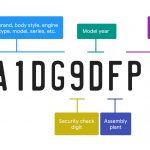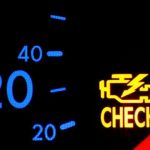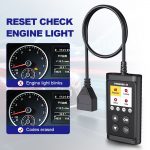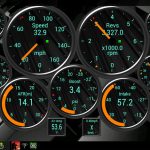Whether you’ve just noticed that your car is making a lot of noises or your engine is misfiring, you might be concerned about your car’s engine code (DTC). If you do, don’t panic. This article will show you how to diagnose these common car problems and solve them yourself. Also read on for more tips. Read on for the solutions to engine misfires, MAP sensor problems, and Leaking fuel injectors.
MAP sensor
When your car displays the diagnostic trouble code P0106, the problem is most likely with the MAP sensor. The MAP sensor measures the absolute pressure in your engine’s intake manifold. The absolute pressure is directly related to the engine load. Common symptoms of a faulty MAP sensor include a lack of power and a rough idle. If you notice that your car is constantly idling too fast or too slowly, it’s likely the problem.
A faulty MAP sensor will result in a DTC, and if this code continues, it indicates that the PCM has a problem. If you’re unable to diagnose the problem on your own, you can consult a car mechanic for guidance. Often, a simple repair can solve the problem. A specialist can replace the MAP sensor and perform a diagnostic test. However, this procedure may not be necessary if the car is new.
The problem may be a simple one, but the cause can be complex. A bad MAP sensor can be contaminated, damaged, or clogged. The heat inside the engine can damage or overcook the sensor’s electronics. Additionally, a bad MAP sensor can damage your vehicle’s vacuum lines. A bad MAP sensor will cause problems with the engine’s load calculations and the ratio of air to fuel.
Often, the faulty MAP sensor won’t throw a DTC until it dies. To diagnose a faulty MAP sensor, you can turn the ignition switch from Off to Run. Check the indicators for a flashing light. If a faulty MAP sensor causes the MAP sensor to fail, you will see a flashing Power Limited light and a DTC 13 or 14. Depending on your car model, you’ll likely see a code P0108.
Using a digital OBD II scan tool, observe the MAP Sensor parameter. The parameter should increase to approximately 2,000 RPM and then decrease to a stable idle speed. The MAP sensor’s output voltage should increment to a higher value after reaching 2,000 RPM. At idle speed, the MAP sensor should remain near the BARO value. If the engine speeds fluctuate during this test, then the problem may be the MAP sensor.
Leaking fuel injectors
There are three reasons why your car may show an engine code for leaking fuel injectors. A dirty or clogged O2 sensor is the most common cause of this problem, and dirty fuel injectors can also contribute to this code. To make your car run leaner, try replacing the air or fuel filters or cleaning the fuel injectors. Then check the engine computer’s fuel trim and see if your car is running rich or lean.
A leaking fuel injector may be one of the reasons your car’s engine code dtc is illuminated. This code indicates that the fuel injectors are causing a substantial drop in fuel pressure. Your car’s PCM controls fuel pressure from the pump and injectors, and it monitors them with sensors. The sensors can be faulty, and this could be the cause of the fuel pressure drop.
This problem could also cause excessive oxygen in the exhaust system, causing a lean engine code. If this happens, the fuel pump could be faulty or you could have a vacuum leak. In either case, you need to fix the fuel system as soon as possible. Luckily, you can find many easy ways to fix this problem with an On-Board Diagnostic reader. If you have a question about this code, Jerry has compiled some helpful information for you. Just keep in mind that it does not apply to every car.
Although it’s not necessary to replace your fuel injectors if the engine code dtc is displayed, you should consult a mechanic if your injectors are leaking. A bad fuel injector can lead to engine misfire, lack of power, black smoke, and other problems with the engine. Also, a bad fuel injector can lead to poor fuel economy and poor engine performance.
The first thing that your mechanic will check if you suspect your vehicle has a leaking fuel injector problem is your fuel pressure. Propane is an excellent alternative fuel to diesel. Propane is a better choice because it bypasses the entire electronic fuel injection system. Bypassing the electronic fuel injection system, propane will cause no engine problems and can actually increase fuel mileage.
Leaking fuel pressure regulator
If you’re experiencing a dTC, you may have a leaking fuel pressure regulator. In order to repair a leaking regulator, you must first determine what caused the problem. If it’s a simple leak, replacing the regulator should solve the problem. Here’s how to do it. Remove the fuel pressure regulator and inspect the filter screen to make sure it’s free of debris. Then, push the regulator into its housing on the fuel rail. Be sure to tighten the regulator retainer and the fuel return pipe to properly secure it.
A manual fuel pressure tester is required for this test. In addition to using the tester, you must inspect the vacuum line of the fuel pressure regulator. If gasoline drips are visible, it’s possible that the fuel pressure regulator is leaking. If the regulator is leaking fuel, replace it or repair the problem. If you notice any of these symptoms, your car’s engine is likely suffering from a fuel leak.
Leaking fuel pressure regulator is a common cause of a P0087 code. It’s a problem in the fuel rail that restricts the flow of fuel to your car. The problem can be caused by a leak in the high pressure section. In other cases, it’s caused by something else in your vehicle. In this case, a diagnostic scan tool is required to determine the exact problem. Leaking fuel pressure regulator is often caused by a clogged fuel filter and/or a fuel supply line.
A leaking fuel pressure regulator can lead to poor fuel economy and poor performance. The fuel pressure regulator can also leak into the engine’s vacuum lines, leading to cracking or splitting of rubber vacuum hoses. In addition to these symptoms, a leaking fuel pressure regulator may also cause engine misfires. If you experience these problems, you may want to repair the fuel pressure regulator as soon as possible.
Another possible cause of dtc is a failed fuel pump. Although not the most common, fuel pump failures can cause regulator problems. In addition to the fuel pump, a leaking fuel pressure regulator can cause an engine to run rich or lean. These symptoms usually manifest themselves as a black smoke in the exhaust system. If you’re not sure if it’s a leaking fuel pressure regulator, contact a mechanic to check the condition of your car.
Engine misfires
When your vehicle experiences engine misfires, it might be the result of several different problems. While some misfires allow you to keep driving, others result in engine stalling. The longer the misfires are left unchecked, the more damage is done. While misfires may only cause a minor inconvenience, ignoring them can result in major problems later on. When they persist, they can even lead to the destruction of your engine.
The cause of engine misfire codes is often a major difference in air-fuel ratio. A dirty, miscalibrated, or electrically defective mass air flow sensor can cause the code to be stored. Some vehicles may suffer from this issue, including the 2001 Hyundai with intermittent poor cold driveability and the 2000 Nissan Sentra with poor idle capability. However, this is only a partial list of causes. To determine which cause your misfire code, follow the steps in this article.
A misfire can affect the performance of a vehicle, including fuel economy and emissions. Vehicles that misfire frequently are likely to fail emissions tests because the hydrocarbon emissions produced by misfiring engines are too high. Misfires may be the result of a variety of different problems, including ignition, compression, and fuel related. In severe cases, the Check Engine light will illuminate. The diagnostic connector is located under the dash, near the steering column.
Regardless of the cause, engine misfires can be dangerous and difficult to diagnose. If you’ve already checked your vehicle for other problems, you must rule out these before addressing the misfire issue. Sometimes, the engine misfire is caused by the front/rear differential, transfer case, or driveshaft. A mechanic should investigate the cause of the misfires, since misfires can lead to dangerous situations for everyone on the road.
There are several common causes of engine misfires, including a dirty spark plug, worn valves, or a cracked piston. Additionally, a poor fuel injector, a plugged spark plug wire, and a weak coil in a distributorless ignition system can all cause misfires. You should also check the exhaust system for leaks. There are also other possible causes of misfires, but you should always consult a mechanic before attempting to fix your car.






